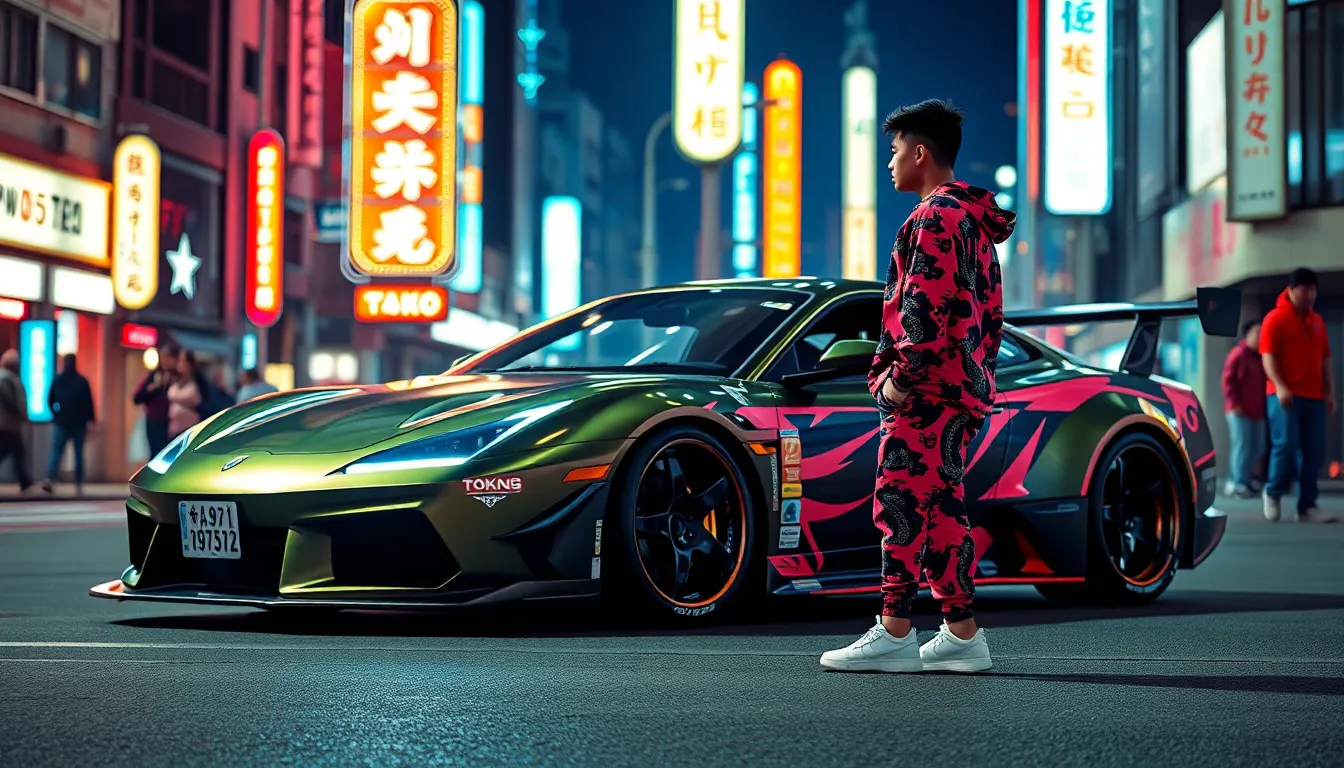Tokyo’s streets pulse with automotive artistry that’s captivated car enthusiasts worldwide. We’re witnessing a unique fusion where cutting-edge technology meets decades of refined craftsmanship, creating vehicles that aren’t just transportation—they’re rolling masterpieces. From the neon-lit districts of Shibuya to the underground parking garages of Harajuku, Japanese automotive culture has redefined what it means to express personality through cars.
The Tokyo car aesthetic isn’t just about flashy modifications or expensive imports. We’ve discovered it’s a deeply rooted philosophy that balances respect for engineering excellence with bold creative expression. Whether it’s the subtle elegance of a perfectly lowered sedan or the aggressive stance of a modified sports car, Tokyo’s automotive scene represents a level of attention to detail that’s become legendary.
This distinctive approach has influenced global car culture in ways we’re still discovering. Let’s explore how Tokyo’s streets became the ultimate canvas for automotive creativity.
Neon-Lit Street Racing Culture: The Heart of Tokyo Cars Aesthetic
Tokyo’s streets transform into electric arteries after dark, where automotive passion meets visual spectacle. We witness a culture that’s defined the global perception of Japanese street racing aesthetics.
Midnight Club and Wangan Racing Influence
Underground racing groups like the legendary Midnight Club have shaped Tokyo’s automotive aesthetic since the 1980s. We see their influence in the preference for sleek, aerodynamic modifications that combine function with aggressive styling. These crews favored dark paint schemes with minimal but purposeful bodywork, creating a sophisticated street presence that contrasted sharply with flashier tuning styles.
Wangan racing culture brought high speed engineering to Tokyo’s expressways, influencing car aesthetics toward clean lines and purposeful modifications. We observe how this movement prioritized subtle visual cues like front splitters, rear diffusers, and understated wing designs. The aesthetic emphasized precision over ostentation, with cars featuring matte black accents and carbon fiber elements that suggested serious performance capability.
Modern Tokyo street culture continues this legacy through carefully curated builds that honor racing heritage. We find enthusiasts incorporating classic Midnight Club color schemes like midnight blue, deep black, and charcoal gray into contemporary vehicles.
LED Underglow and Neon Accent Lighting
Vibrant underglow lighting has become synonymous with Tokyo’s nighttime car culture, creating moving art installations on city streets. We see drivers using programmable LED systems that cycle through color spectrums, transforming ordinary vehicles into cyberpunk inspired machines. These lighting setups often synchronize with music or react to engine RPMs, adding ever-changing visual elements to the driving experience.
Interior accent lighting complements exterior underglow through dashboard strips, footwell illumination, and seat piping that glows in coordinated colors. We notice how Tokyo car enthusiasts layer multiple lighting zones throughout their vehicles, creating immersive environments that feel like spaceship cockpits. Popular color choices include electric blue, neon green, and hot pink that reflect the city’s anime and gaming culture influences.
Street photography and social media have amplified the popularity of neon lit car aesthetics beyond Tokyo’s borders. We document how these luminous displays create striking contrasts against Tokyo’s urban backdrop, with cars appearing to float through rain slicked streets like digital phantoms.
Lowrider and Stance Culture: Creating the Perfect Silhouette
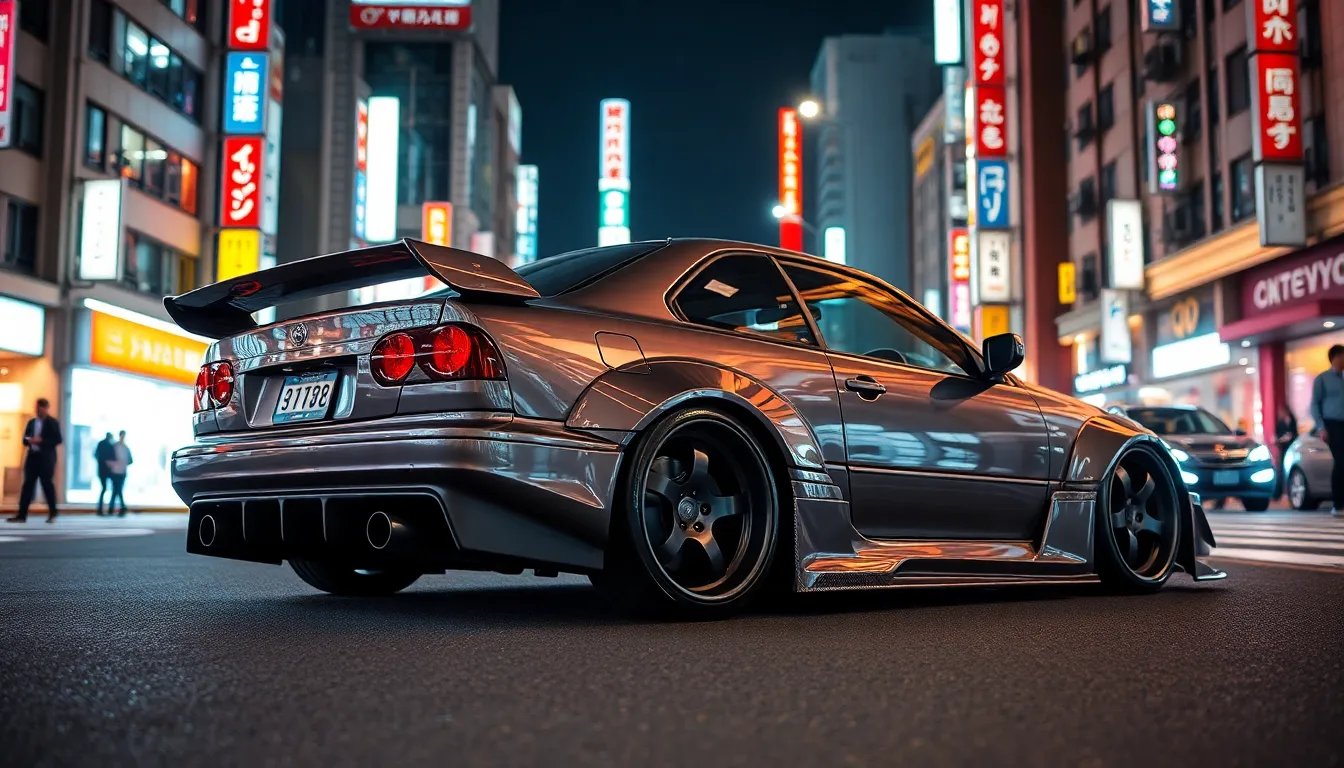
Tokyo’s stance culture transforms ordinary vehicles into rolling sculptures that challenge conventional automotive proportions. We’ve witnessed this movement evolve from California lowrider traditions into a distinctly Japanese aesthetic that prioritizes visual impact through dramatic suspension modifications.
Air Suspension and Coilover Modifications
Air suspension systems allow Tokyo enthusiasts to achieve the most dramatic stance transformations we’ve ever documented in urban car culture. These setups enable drivers to drop their vehicles to pavement-scraping heights for car shows while maintaining practical ride heights for daily driving. Popular brands like Air Lift Performance and Accuair dominate the Tokyo scene with their precise control systems that can adjust each corner independently.
Coilover modifications represent the foundation of serious stance builds throughout Tokyo’s modified car community. Premium brands such as Tein, Cusco, and KW Variant create specialized setups that can lower vehicles by 3-4 inches while maintaining acceptable ride quality. Street-focused builds often combine ultra-low static heights with aggressive camber angles that create the distinctive “tucked wheel” appearance.
Quality installations require precise alignment adjustments to prevent tire wear issues that commonly plague improperly executed stance builds. Tokyo shops like Liberty Walk and Rocket Bunny have perfected installation techniques that balance extreme aesthetics with mechanical reliability. Advanced builders incorporate air management systems with smartphone apps that allow instant ride height adjustments from inside the vehicle.
Wide Body Kits and Fender Flares
Wide body modifications create the aggressive silhouettes that define Tokyo’s most Instagram-worthy stance builds. These extensive bodywork changes accommodate the massive wheel and tire combinations that stance culture demands while creating distinctive proportions that set modified cars apart from factory specifications.
Rocket Bunny leads the Tokyo wide body scene with their signature bolt-on fender flares that add 3-6 inches of width per side. Their kits transform compact cars like the Toyota 86 and Mazda Miata into track-ready looking machines with pronounced wheel arches. Liberty Walk offers even more extreme transformations with their complete body replacements that can add up to 8 inches of total width.
Installation complexity varies dramatically between different wide body approaches used across Tokyo’s modification shops. Bolt-on flares require minimal cutting and can be reversed if needed while full wide body conversions involve extensive metalwork and paint matching. Professional installations typically cost between $8,000-$15,000 including paint and labor at top Tokyo shops.
Proper fitment ensures that wide body modifications complement rather than overwhelm the vehicle’s original design language. We’ve observed that the most successful builds maintain proportional relationships between wheel size, fender width, and overall vehicle stance. Carbon fiber construction reduces weight while adding premium aesthetics that align with Tokyo’s high-tech automotive culture.
JDM Tuning Philosophy: Function Meets Form
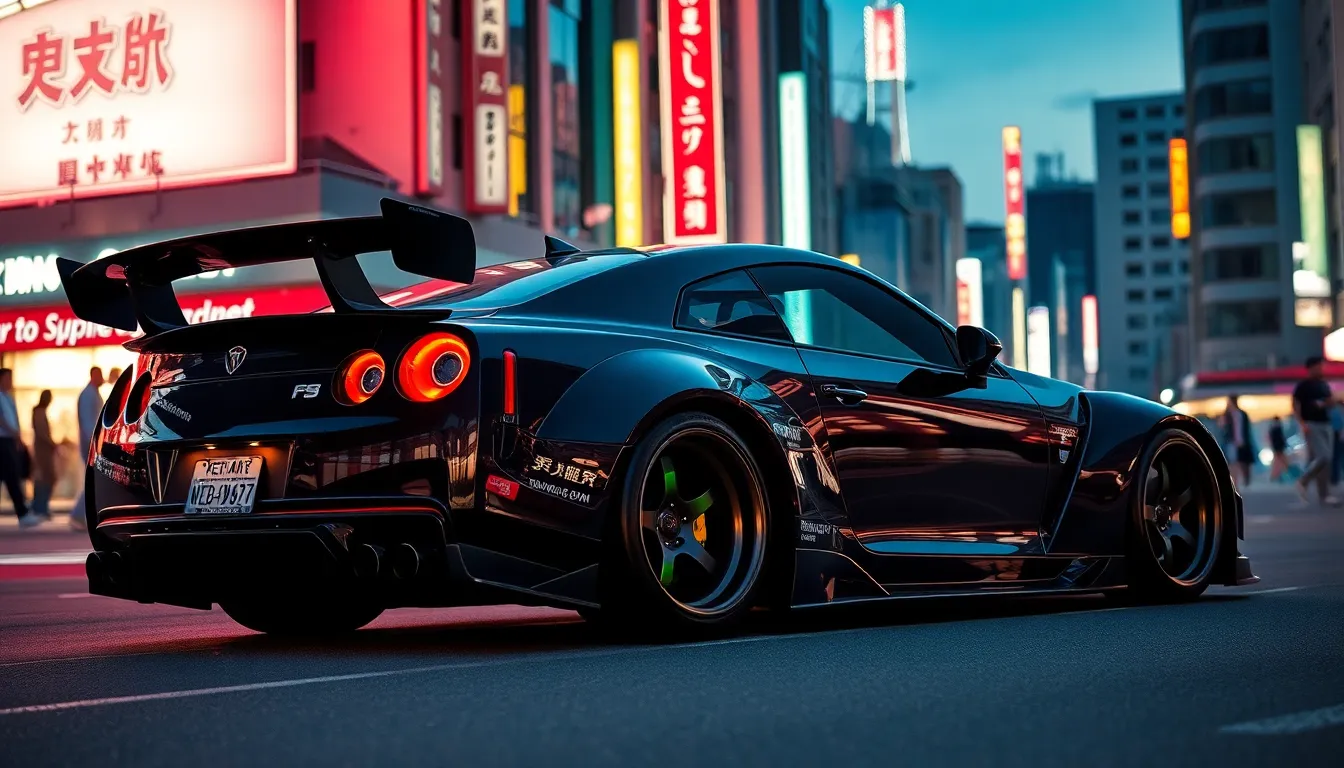
JDM tuning culture represents the perfect marriage between engineering excellence and aesthetic refinement. We’ve observed how Tokyo’s automotive enthusiasts prioritize modifications that deliver tangible performance gains while creating visually striking results.
Performance Modifications with Visual Impact
Turbocharger upgrades serve as the foundation of JDM performance philosophy, with brands like HKS and Greddy delivering both power increases and distinctive blow-off valve sounds that announce a vehicle’s capabilities. We see enthusiasts choosing intercoolers that feature polished aluminum piping and aggressive front-mount positioning, creating functional cooling systems that double as visual centerpieces. Engine bay modifications focus on components like carbon fiber cold air intakes from Mugen or Spoon Sports, which improve airflow while showcasing high-quality materials through transparent engine covers.
Exhaust systems from Tomei and Tanabe offer another perfect example of form following function, producing exact sound signatures while featuring titanium construction and heat-treated tips that develop distinctive blue coloring over time. We’ve documented how these systems often incorporate adjustable baffles, allowing drivers to modify sound levels for different driving situations while maintaining the aggressive aesthetics that define JDM culture.
Brake upgrades represent the ultimate intersection of safety and style, with brands like Endless and Project Mu offering colorful calipers that showcase stopping power through distinctive wheel gaps. We observe how enthusiasts select drilled and slotted rotors not just for improved heat dissipation, but for the aggressive visual impact they create behind lightweight forged wheels from companies like Rays Engineering or Work Wheels.
Authentic Japanese Brand Preferences
Authentic Japanese manufacturers hold sacred status within Tokyo’s tuning community, with brands like Mugen commanding premium prices due to their Honda racing heritage and limited production numbers. We’ve tracked how enthusiasts specifically seek out Spoon Sports components, which offer race-proven performance credentials alongside the company’s distinctive yellow and blue color schemes that instantly identify serious builds.
Tuning houses like RE Amemiya and Mazdaspeed maintain cult followings among rotary engine enthusiasts, while brands such as Nismo and STI represent factory-backed performance divisions that bridge the gap between OEM reliability and aftermarket innovation. We see collectors paying significantly more for vintage components from defunct companies like Mine’s or Top Secret, viewing these parts as investment pieces that represent exact eras of Japanese tuning culture.
Regional tuning shops like Garage Mak and Option2 have developed international reputations for their unique aesthetic approaches, often incorporating traditional Japanese design elements into modern performance applications. We’ve observed how these smaller operations influence global trends even though limited production volumes, with their custom work appearing regularly in international automotive media and inspiring replica builds worldwide.
Engine management systems from Japanese companies like AEM Infinity and Haltech receive preference over European alternatives, not just for their technical capabilities but for their integration with traditional JDM sensor packages and wiring harnesses that maintain authentic underhood appearances.
Anime and Manga-Inspired Vehicle Wraps
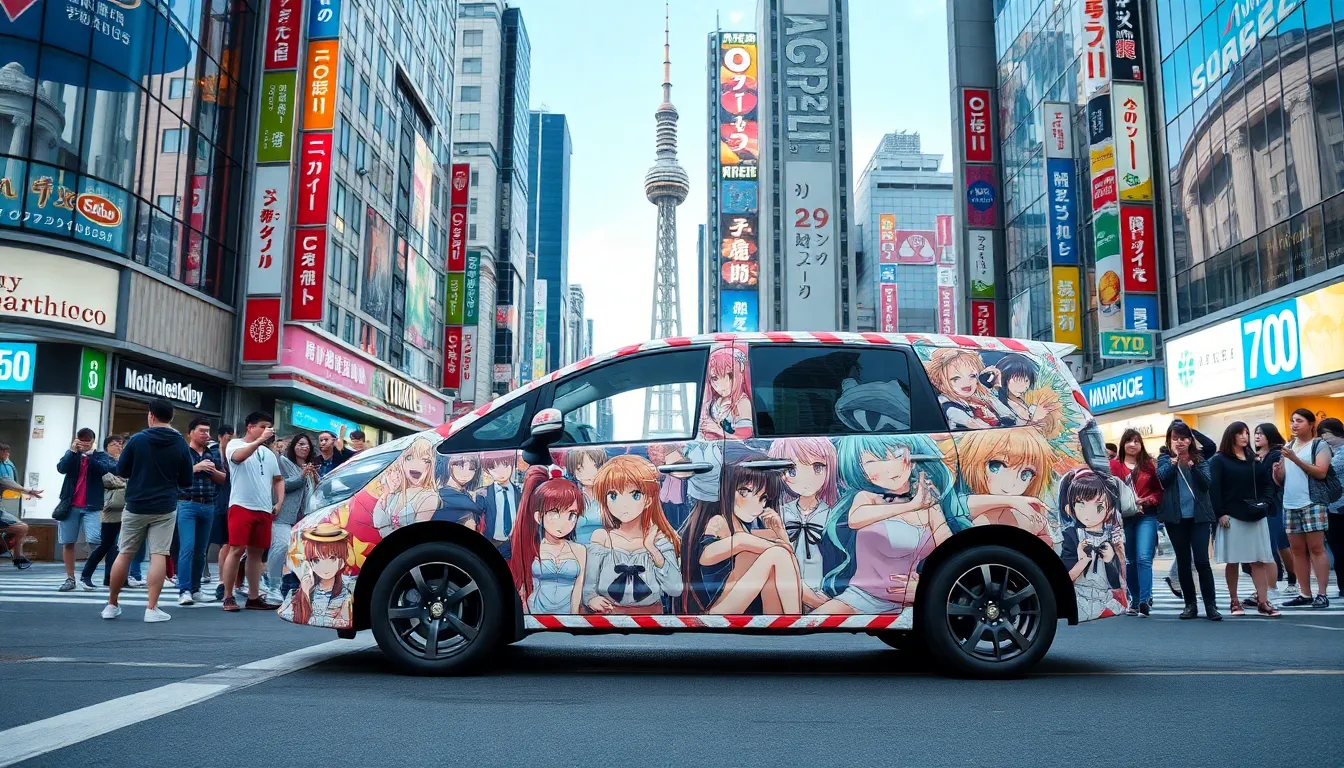
Tokyo’s automotive canvas extends far beyond performance modifications into the vibrant industry of pop culture expressions. Vehicle wraps featuring beloved characters and anime aesthetics represent one of the most distinctive aspects of Tokyo car culture.
Itasha Culture and Character Graphics
Itasha vehicles transform ordinary cars into moving shrines dedicated to anime and gaming characters. This subculture emerged in Tokyo’s Akihabara district during the early 2000s, where enthusiasts began covering their vehicles with vinyl wraps featuring popular anime characters from series like Love Live!, Initial D, and Hatsune Miku.
Professional wrap installations typically cost between $3,000 and $8,000 depending on vehicle size and design complexity. Tokyo shops like Wrap King and Auto Select specialize in these intricate designs, using premium vinyl materials from 3M and Avery Dennison that maintain color vibrancy for 5-7 years under Japanese weather conditions.
Character placement follows exact aesthetic principles that maximize visual impact while respecting vehicle proportions. Side panel designs often feature full body character illustrations, while hood graphics showcase facial portraits or action scenes. Rear window perforated vinyl allows for interior visibility while displaying dramatic character poses.
Quality itasha builds incorporate multiple design elements beyond character graphics. Matching wheel colors, custom LED underglow systems, and character themed interior accessories create cohesive visual narratives. Many enthusiasts coordinate their vehicle colors with their favorite character’s signature hues.
Social media platforms like Twitter and Instagram amplify itasha culture visibility throughout Tokyo’s car communities. Owners regularly participate in character themed meetups at locations like Daikoku Parking Area, where hundreds of anime wrapped vehicles gather for photo sessions and cultural exchange.
Custom Paint Jobs with Pop Culture References
Airbrushed anime artwork represents the premium tier of Tokyo’s pop culture automotive expressions. Master artists like Takeshi Yamada and Hiroshi Nakamura create one off masterpieces that can cost $15,000-$30,000 for complete vehicle coverage, transforming cars into rolling galleries.
Studio Ghibli themes dominate high end custom paint applications across Tokyo’s automotive scene. Totoro, Princess Mononoke, and Spirited Away characters appear frequently on luxury vehicles, with owners investing in museum quality clear coat systems that protect the artwork for decades.
Gaming franchise references extend beyond anime into popular video game properties like Pokemon, Final Fantasy, and Dragon Ball Z. These designs often incorporate ever-changing action sequences that wrap around vehicle curves, creating immersive storytelling experiences that change perspective as viewers move around the car.
Holographic and color shifting paints add technological sophistication to pop culture themed vehicles. Tokyo artists use ChromaFlair and MultiChrome pigments that reveal different character details depending on viewing angles and lighting conditions, creating interactive visual experiences.
Traditional Japanese art techniques merge with modern pop culture themes in premium custom paint applications. Ukiyo e style backgrounds combined with contemporary anime characters create unique fusion aesthetics that honor both classical and modern Japanese cultural expressions.
Pearl and metallic base coats enhance character artwork depth while maintaining Tokyo’s sophisticated automotive standards. House of Kolor and Tamiya paints provide the foundation colors that make character details pop under Tokyo’s urban lighting conditions, ensuring visibility during both day and night driving scenarios.
Cyberpunk and Futuristic Design Elements
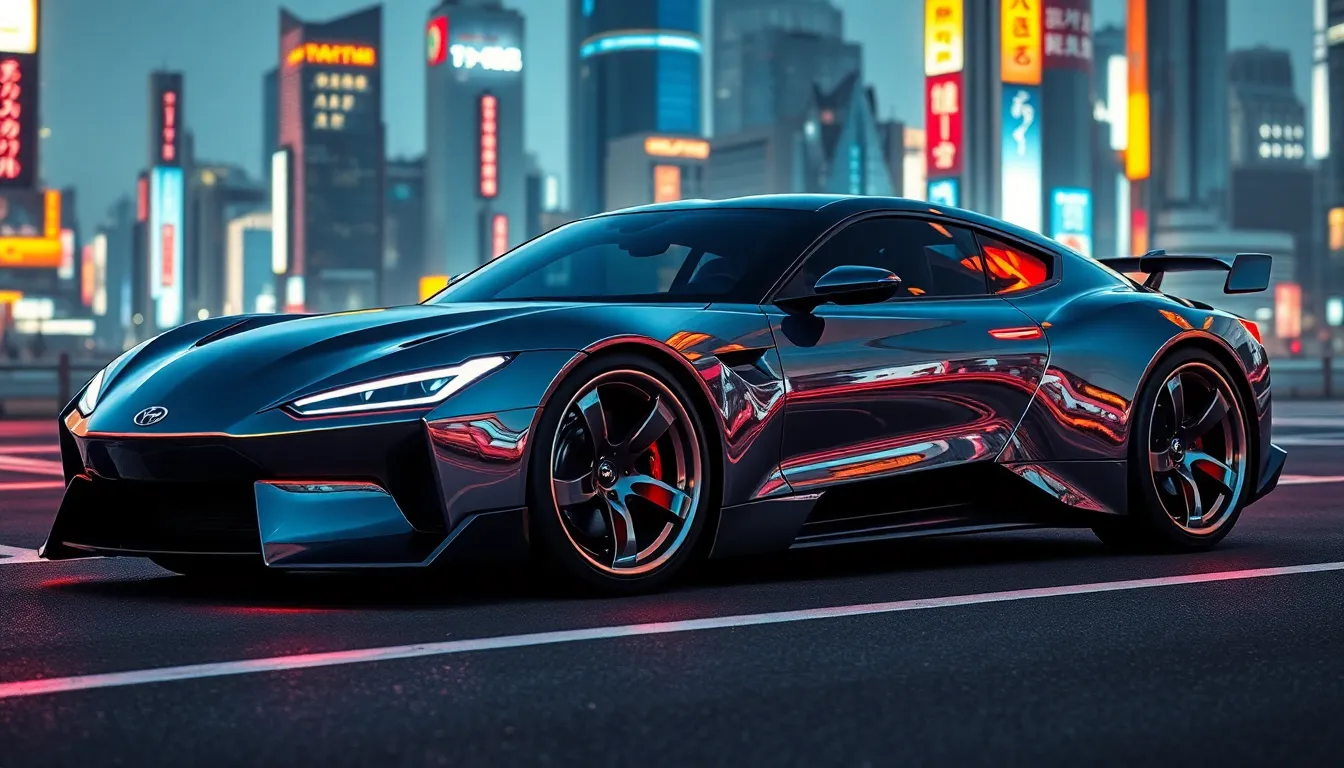
Tokyo’s cyberpunk aesthetic draws inspiration from the city’s neon-soaked streets and futuristic skyline. Automotive enthusiasts embrace this visual language through cutting-edge materials and technologies that blur the line between reality and science fiction.
Chrome and Metallic Finishes
Chrome treatments transform vehicles into mirror-like sculptures that reflect Tokyo’s urban industry with stunning clarity. We’ve observed enthusiasts selecting brushed aluminum, polished titanium, and rose gold finishes to create distinctive metallic personalities that shift with changing light conditions. Professional applications require specialized techniques including vapor deposition and electroplating processes that ensure durability against Japan’s humid climate.
Metallic vinyl wraps offer more accessible alternatives to traditional chrome plating, with brands like 3M and Avery Dennison producing films that mimic precious metals at fraction of the cost. Installation specialists in Tokyo’s Shibuya and Harajuku districts charge between $2,500 and $4,500 for complete vehicle transformations. These finishes create dramatic visual impact under Tokyo’s street lighting, producing mirror effects that amplify the city’s cyberpunk atmosphere.
Advanced metallic treatments include brushed steel patterns, anodized aluminum textures, and liquid metal effects that respond to temperature changes. We notice these applications work particularly well on angular vehicles like Lamborghinis and McLarens, where geometric surfaces enhance the futuristic aesthetic. Premium installations incorporate color-shifting properties that transition between silver, blue, and purple tones depending on viewing angles.
Holographic and Color-Changing Wraps
Holographic materials create prismatic effects that fragment light into rainbow spectrums across vehicle surfaces. We’ve documented installations featuring dichroic films that shift between multiple color combinations, transforming cars into ever-changing art pieces that change throughout the day. These wraps use advanced nanotechnology that manipulates light wavelengths to produce iridescent effects impossible with traditional paint.
Professional wrap shops in Tokyo work with materials from companies like Orafol and Hexis that offer thermochromic properties responding to temperature fluctuations. Installations range from $4,000 to $8,000 depending on vehicle size and complexity of the design. We observe these treatments gaining popularity among supercar owners who want unique visual signatures that complement Tokyo’s high-tech environment.
Color-changing capabilities extend beyond temperature sensitivity to include UV-reactive materials that shift hues under different lighting conditions. Night reveals entirely different color palettes as street lights and neon signs interact with the reflective surfaces. We’ve seen installations that incorporate fiber optic elements and LED integration for active color control, allowing owners to modify their vehicle’s appearance through smartphone apps.
Maintenance requirements for holographic wraps include specialized cleaning products and techniques that preserve the optical properties of the materials. Professional detailing services in Tokyo charge premium rates for these treatments, with monthly maintenance packages ranging from $300 to $600 depending on the complexity of the installation.
Minimalist Japanese Design Principles
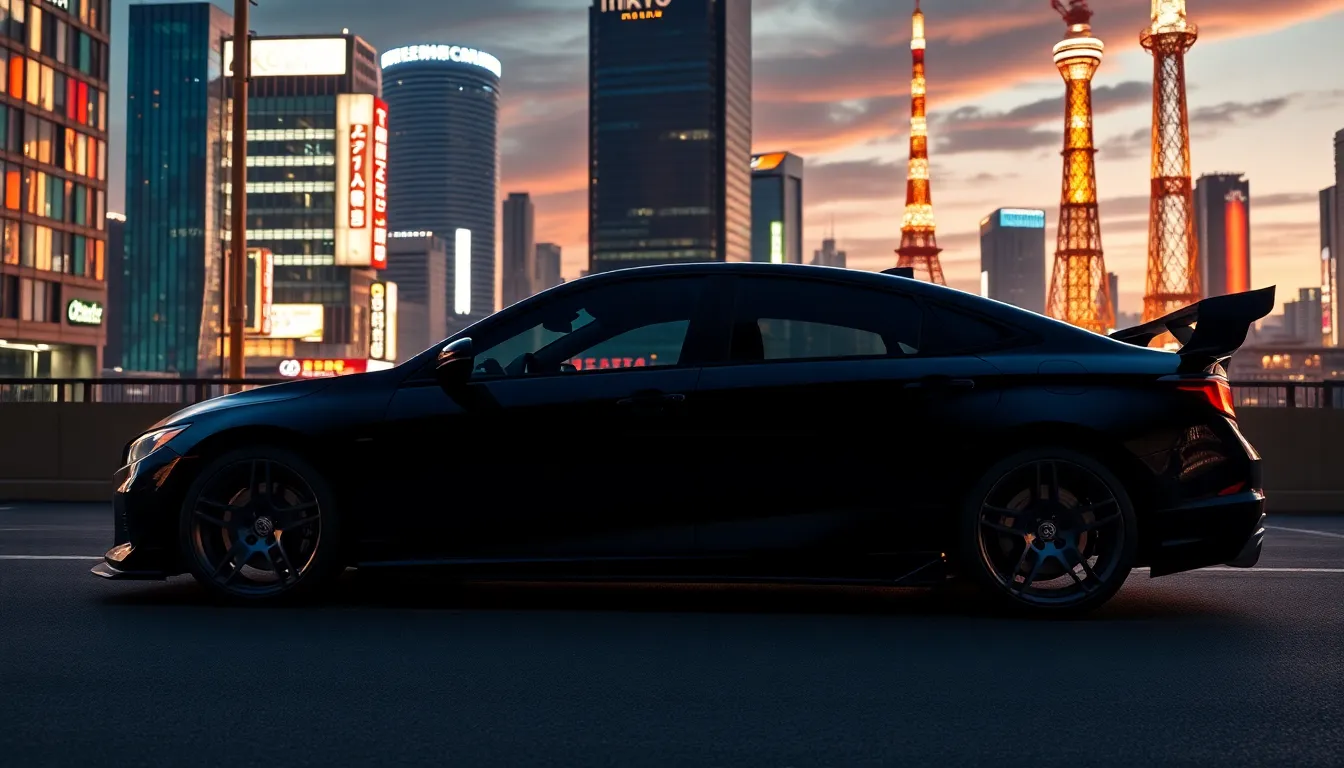
Tokyo’s automotive aesthetic embraces simplicity over excess, creating vehicles that achieve maximum visual impact through thoughtful restraint. We witness this philosophy transforming even the most aggressive builds into studies of purposeful design.
Clean Lines and Subtle Modifications
Clean bodywork defines the foundation of authentic Tokyo car aesthetics, where every modification serves both form and function. We see enthusiasts removing unnecessary trim pieces and badges to create uninterrupted surfaces that emphasize natural proportions. Professional body shops in districts like Shibuya and Harajuku specialize in seamless integration, welding mounting points and refinishing panels to factory standards.
Subtle aerodynamic enhancements replace flashy wings and splitters in sophisticated builds throughout Tokyo’s automotive scene. Carbon fiber lip spoilers and understated side skirts provide functional downforce while maintaining elegant proportions. Popular manufacturers like Mugen and Spoon Sports design these components with precise attention to original design language.
Factory-inspired wheel selections complement clean aesthetics, with enthusiasts choosing designs that enhance rather than overwhelm vehicle proportions. Classic options like TE37s and CE28s remain popular for their timeless spoke patterns and lightweight construction. Sizing typically stays within one or two inches of original specifications to preserve balanced proportions.
Engine bay presentations demonstrate the same commitment to cleanliness, featuring color-matched components and hidden wiring harnesses. We observe meticulous attention to detail in these builds, with custom brackets and covers maintaining visual harmony. Professional installations often cost between $2,000 and $4,000 for complete engine bay refinishment.
Interior modifications follow similar principles, removing excessive branding while adding functional upgrades like sports seats and steering wheels. Quality leather work and subtle carbon fiber accents enhance the driving environment without creating visual chaos. Tokyo shops like Recaro and Bride offer custom upholstery services that maintain original aesthetic themes.
Monochromatic Color Schemes
Single-color approaches dominate Tokyo’s refined automotive aesthetic, creating cohesive visual statements that emphasize vehicle proportions over surface complexity. We observe enthusiasts selecting paint colors that complement their vehicle’s natural lines, often choosing sophisticated whites, deep blacks, or muted grays that photograph beautifully against urban backdrops.
White builds represent purity in Tokyo car culture, with pearl and metallic finishes adding depth without compromising the monochromatic theme. Professional paint shops achieve these finishes through multi-stage processes that cost between $5,000 and $12,000 for show-quality results. Maintenance requirements include specialized detailing products and regular clay bar treatments to preserve the lustrous appearance.
Black vehicles create dramatic silhouettes that merge with Tokyo’s nighttime environment, emphasizing wheel and lighting choices through contrast. Enthusiasts often select matching black wheels and trim pieces to maintain visual continuity. Popular options include Volk Racing TE37s in matte black or Work Emotion wheels in gloss black finishes.
Accent pieces in monochromatic builds receive careful consideration, with enthusiasts limiting contrasting colors to functional elements like brake calipers or roll cage components. Red Brembo calipers provide the only color pop on many sophisticated builds, creating focal points that draw attention to performance upgrades. Silver or gray accents appear on intercoolers and exhaust tips, maintaining metallic consistency.
Interior color coordination extends the monochromatic philosophy, with seat materials and trim pieces matching exterior themes. Black interiors dominate, often featuring subtle red stitching that echoes brake caliper colors. Professional upholstery services in Tokyo specialize in creating these coordinated environments, with complete interior refinishing costing between $3,000 and $8,000.
Street Photography and Social Media Culture
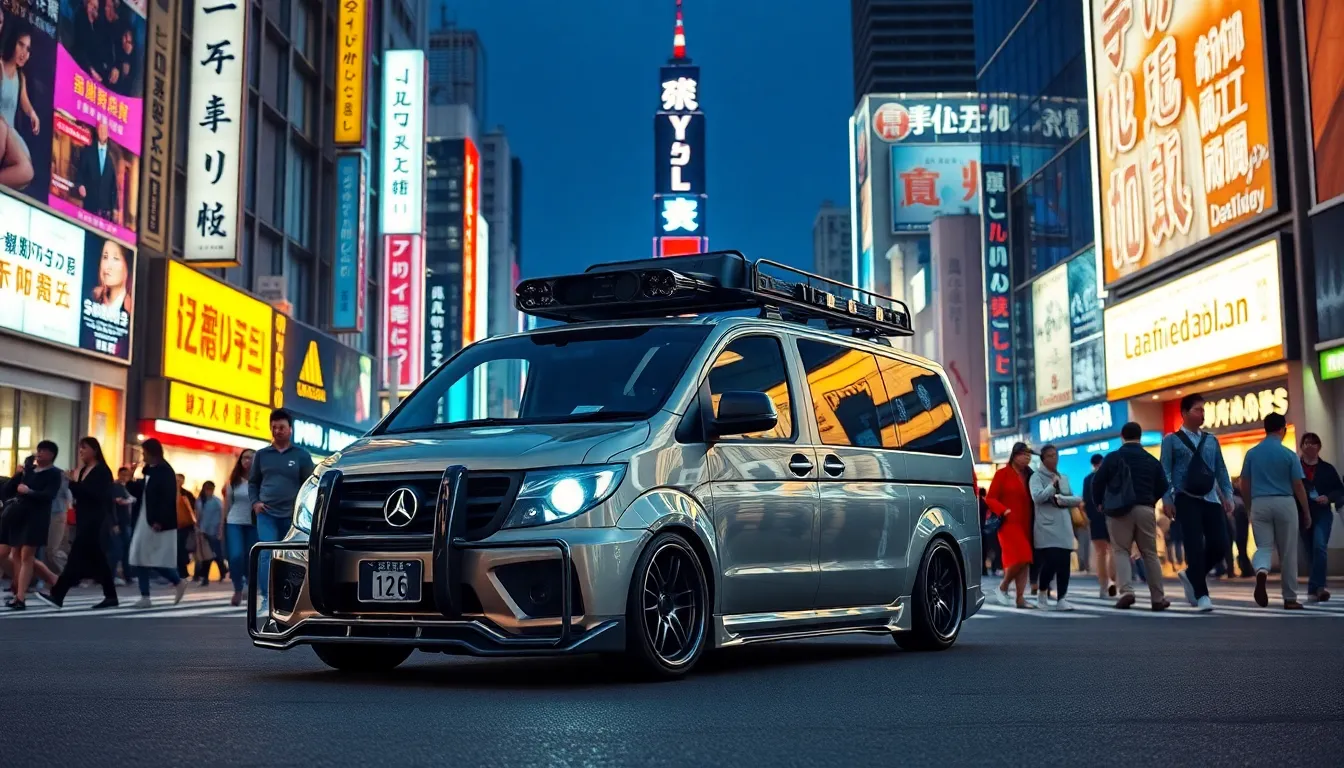
Tokyo’s automotive scene thrives on visual storytelling, where every modified vehicle becomes a potential viral sensation. Social media platforms have transformed car meets from local gatherings into global showcases of automotive artistry.
Instagram-Ready Car Meets and Gatherings
Car meets in Tokyo operate as carefully orchestrated photography sessions where enthusiasts showcase their builds against the city’s iconic backdrops. Popular gathering spots like Daikoku Futo and Oi Pier attract hundreds of modified vehicles every weekend, creating opportunities for photographers to capture rare JDM specimens alongside contemporary builds. These events typically run from 10 PM to 2 AM, providing optimal lighting conditions for dramatic night photography.
Professional photographers command premium rates at major Tokyo car meets, with established shooters charging between $200-$500 per vehicle session. Spontaneous collaborations between car owners and photographers create authentic content that resonates with online audiences, often generating thousands of likes within hours of posting. Many photographers specialize in exact aesthetics like stance culture or cyberpunk themes, building dedicated followings around their unique visual styles.
Hashtag strategies play crucial roles in amplifying Tokyo car content across social platforms, with tags like #TokyoDrift and #JDMDaily generating millions of views monthly. Successful car influencers understand the importance of consistent posting schedules and captivating captions that tell stories behind their builds. Content creators often coordinate outfit colors with their vehicle aesthetics, creating cohesive brand identities that attract automotive sponsors.
Lighting equipment transforms ordinary parking lots into professional studio environments during Tokyo car meets. Photographers use LED panels, colored gels, and fog machines to create cinematic atmospheres that complement each vehicle’s unique character. Advanced setups include wireless flash triggers and battery powered strobes that allow for complex multi-light compositions in remote locations.
Urban Backdrop Integration
Shibuya Crossing serves as one of the most recognizable backdrops for automotive photography, with its neon signs and bustling pedestrian traffic creating ever-changing contrast against sleek modified vehicles. Photographers often work during early morning hours to capture clean shots without crowd interference, utilizing the crossing’s iconic LED displays as natural light sources. The area’s urban energy perfectly complements aggressive wide body kits and vibrant paint schemes.
Rainbow Bridge provides elevated perspectives that showcase Tokyo’s skyline alongside featured vehicles, creating compositions that emphasize the relationship between automotive culture and urban architecture. Night shoots at this location capitalize on the bridge’s illumination system, which cycles through various color schemes that photographers coordinate with vehicle lighting setups. Professional photographers often use telephoto lenses to compress the background and create intimate connections between cars and cityscape.
Tokyo Bay waterfront locations offer reflective surfaces that double the visual impact of illuminated vehicles, with photographers timing shoots around high tide for maximum effect. Odaiba’s futuristic architecture creates sci-fi backdrops that complement cyberpunk-themed builds, while the area’s wide open spaces accommodate large group shoots featuring multiple vehicles. Many photographers prefer these locations for sunrise sessions when warm golden light contrasts beautifully with chrome and metallic finishes.
Parking garages throughout Tokyo’s business districts provide controlled environments where photographers can manipulate lighting conditions without weather interference. Multi-level structures like those in Roppongi Hills offer varied architectural elements that complement different vehicle aesthetics, from minimalist designs to aggressive body kits. These locations allow for creative use of leading lines and geometric patterns that enhance the visual impact of featured vehicles.
Tokyo Drift and Fast & Furious Movie Influence
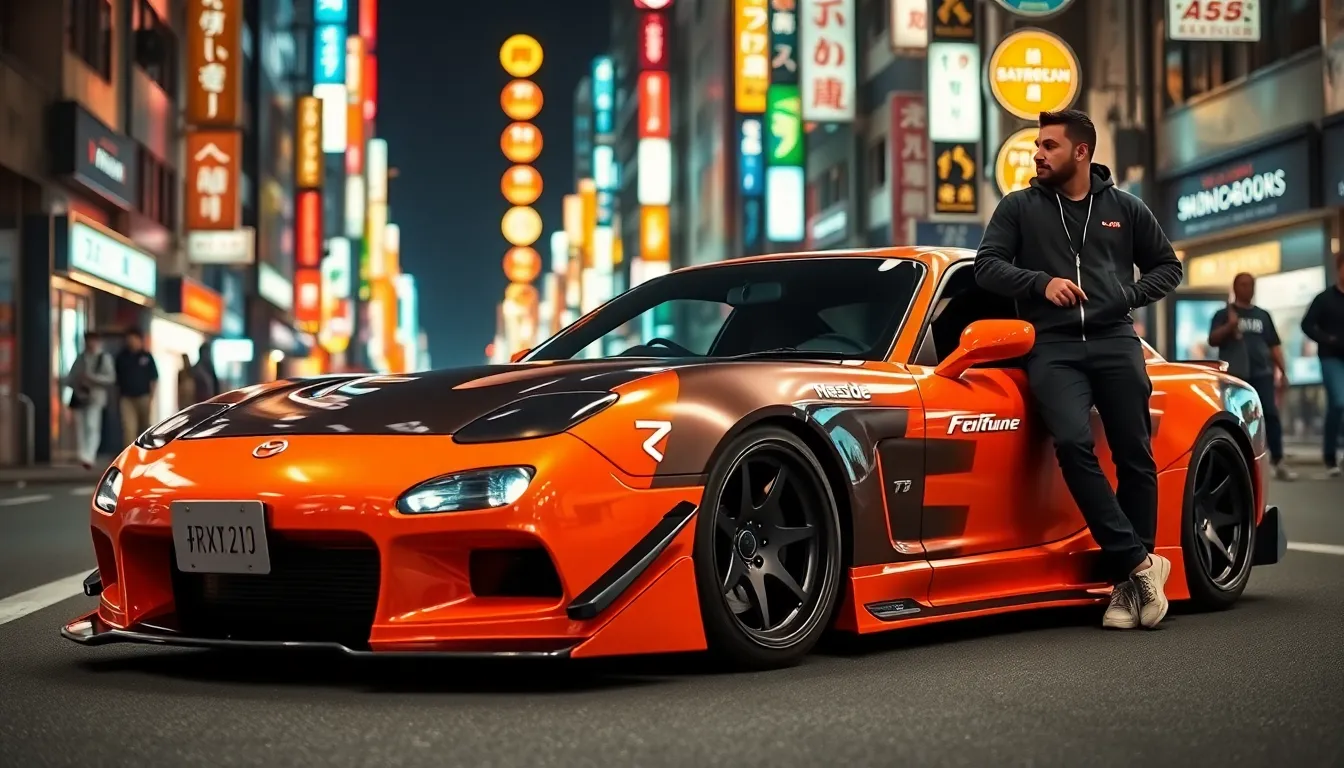
The Fast & Furious franchise transformed Tokyo’s underground racing culture into a global phenomenon, inspiring countless automotive enthusiasts to recreate the iconic vehicles and styling elements showcased in these films.
Replica Builds and Movie Car Tributes
Han’s Mazda RX-7 remains the most replicated Tokyo Drift vehicle, with enthusiasts worldwide seeking to recreate its distinctive orange and black Veilside Fortune body kit. We’ve observed dedicated builders investing $25,000-$40,000 to achieve screen-accurate replicas, sourcing original Veilside components that command premium prices due to their limited availability. Professional shops like RE Amemiya and Mazdaspeed continue producing authentic parts for these builds, maintaining the connection to Tokyo’s tuning heritage.
DK’s 350Z represents another highly sought-after replica, featuring aggressive wide body modifications and distinctive paint schemes that captured audiences’ attention. Builders typically start with clean Z33 chassis, adding Veilside VX widebody kits that dramatically alter the vehicle’s proportions. Installation costs range from $15,000-$25,000 for complete transformations, including custom paint work that matches the movie’s exact color combinations.
Sean’s Mitsubishi Evo IX showcases how American characters embraced Japanese tuning culture, inspiring replica builds that blend JDM aesthetics with accessible performance modifications. Enthusiasts focus on recreating the exact Voltex aerodynamic components and aggressive stance featured in the film, often spending months sourcing authentic parts from Japanese suppliers.
Neela’s 350Z demonstrates feminine influence in Tokyo’s car culture, inspiring builds that incorporate elegant color schemes and refined styling elements. We’ve documented many tribute builds featuring the movie’s signature silver paint with custom graphics, appealing to diverse demographics within the tuning community.
American Muscle Cars with Japanese Styling
Mustang builds inspired by Tokyo Drift showcase how American muscle cars adapt to Japanese aesthetic principles, incorporating wide body kits and aggressive stance modifications that mirror JDM tuning philosophies. Builders typically install coilover suspension systems from Japanese manufacturers like Tein or HKS, lowering these vehicles to achieve the dramatic wheel fitment seen in Tokyo’s street scenes.
Challenger and Camaro projects have emerged featuring Japanese tuning elements like carbon fiber aerodynamics, lightweight wheels, and performance exhaust systems that reflect Tokyo’s engineering focus. Professional shops charge $30,000-$50,000 for complete American muscle transformations that incorporate authentic Japanese components and styling cues.
Engine bay modifications on American muscle cars now feature Japanese aftermarket parts, with builders installing turbocharger systems from companies like HKS or Trust to achieve power levels that complement the aggressive visual modifications. These hybrid builds represent cultural fusion between American automotive heritage and Tokyo’s precision tuning approach.
Wheel and tire combinations follow Japanese sizing conventions, with builders selecting aggressive offsets and stretch tire setups that create the distinctive stance associated with Tokyo’s car culture. Popular choices include Work Emotion wheels and Rays Engineering designs that maintain the authentic JDM aesthetic while accommodating American muscle car specifications.
Seasonal Modifications and Temporary Aesthetics
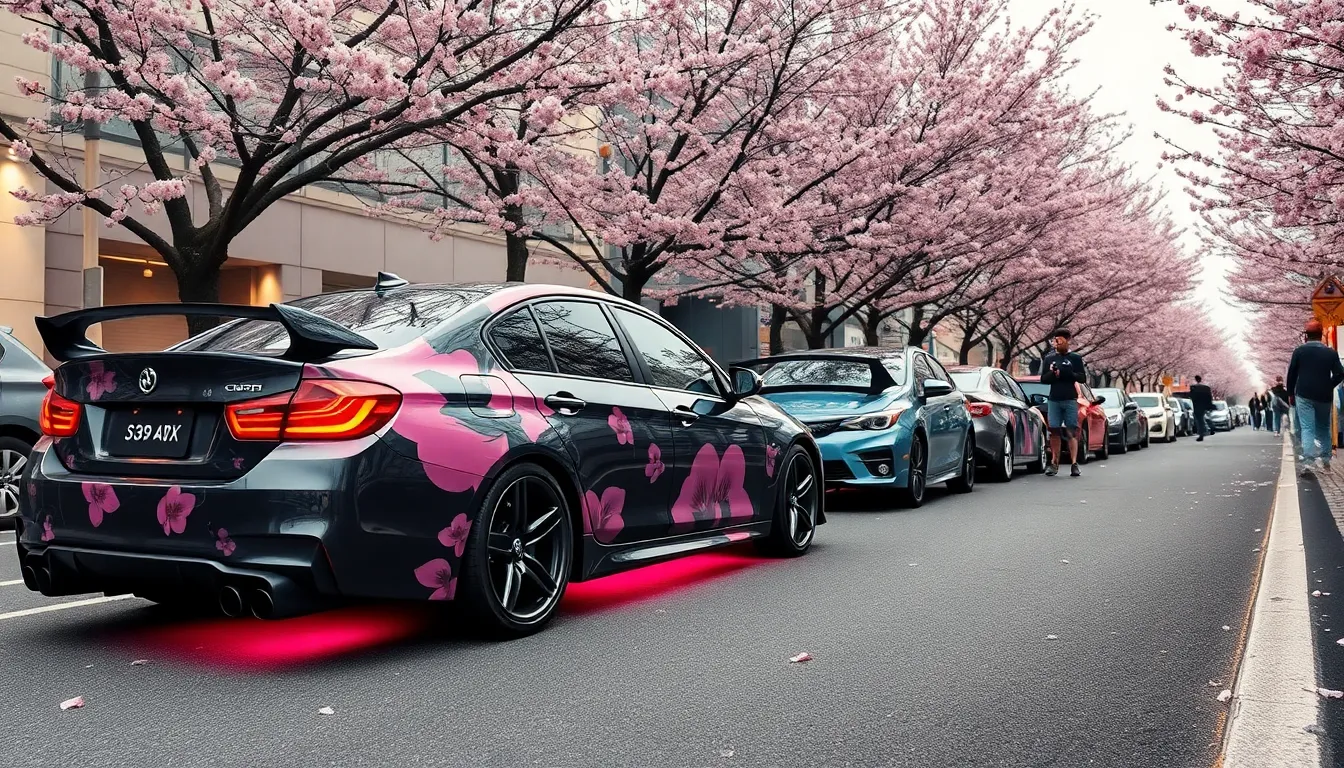
Tokyo’s automotive enthusiasts embrace the city’s seasonal celebrations through temporary vehicle modifications that capture the essence of Japanese cultural moments. These aesthetic transformations demonstrate the flexibility and creativity within Tokyo’s car culture community.
Cherry Blossom Season Themes
Cherry blossom season transforms Tokyo’s automotive scene into a celebration of Japan’s most beloved natural phenomenon. Vehicle wraps featuring delicate sakura petals and cherry blossom branches become increasingly popular during spring months, with professional installations costing between $1,500 and $3,500 for partial coverage designs.
Temporary vinyl decals offer budget conscious enthusiasts access to seasonal aesthetics without permanent modifications. These removable graphics showcase pink and white color schemes that complement the city’s blooming industry, creating harmonious connections between vehicles and Tokyo’s natural beauty.
Pink lighting accents gain popularity during sakura season, with LED underglow systems programmed to display soft pink hues that mirror the blossoms above. Interior ambient lighting receives similar treatment, bathing cabin spaces in warm pink tones that enhance the seasonal atmosphere.
Wheel modifications reflect cherry blossom themes through specialized powder coating in pearl white and rose gold finishes. These limited time treatments command premium pricing from Tokyo’s custom shops, with complete sets ranging from $2,000 to $4,500 depending on wheel size and complexity.
Festival and Holiday-Inspired Decorations
Summer matsuri festivals inspire vibrant temporary decorations that transform vehicles into rolling celebrations of Japanese culture. Traditional lantern designs appear on vinyl wraps and magnetic decals, incorporating authentic festival imagery with modern automotive aesthetics.
Golden Week celebrations drive demand for patriotic color schemes featuring red, white, and the rising sun motif. Temporary paint treatments using washable automotive paints allow enthusiasts to participate in national celebrations while maintaining their vehicle’s original finish integrity.
New Year modifications embrace traditional Japanese symbols through temporary installations of good luck charms and auspicious imagery. Shimekazari inspired front grille decorations and daruma themed wheel center caps create festive appearances that honor cultural traditions.
Halloween brings Western influenced aesthetics into Tokyo’s car scene, with temporary horror themed wraps and glow in the dark vinyl applications gaining traction among younger enthusiasts. Professional wrap shops report 40% increases in temporary installation requests during October, with ghost and anime character combinations proving most popular.
Winter illumination seasons inspire elaborate lighting displays that rival Tokyo’s famous Christmas illuminations. Synchronized LED systems create moving light shows that transform parking lots into automotive winter wonderlands, with complete installations ranging from $800 to $2,500 depending on complexity and programming requirements.
High-Tech Interior Modifications
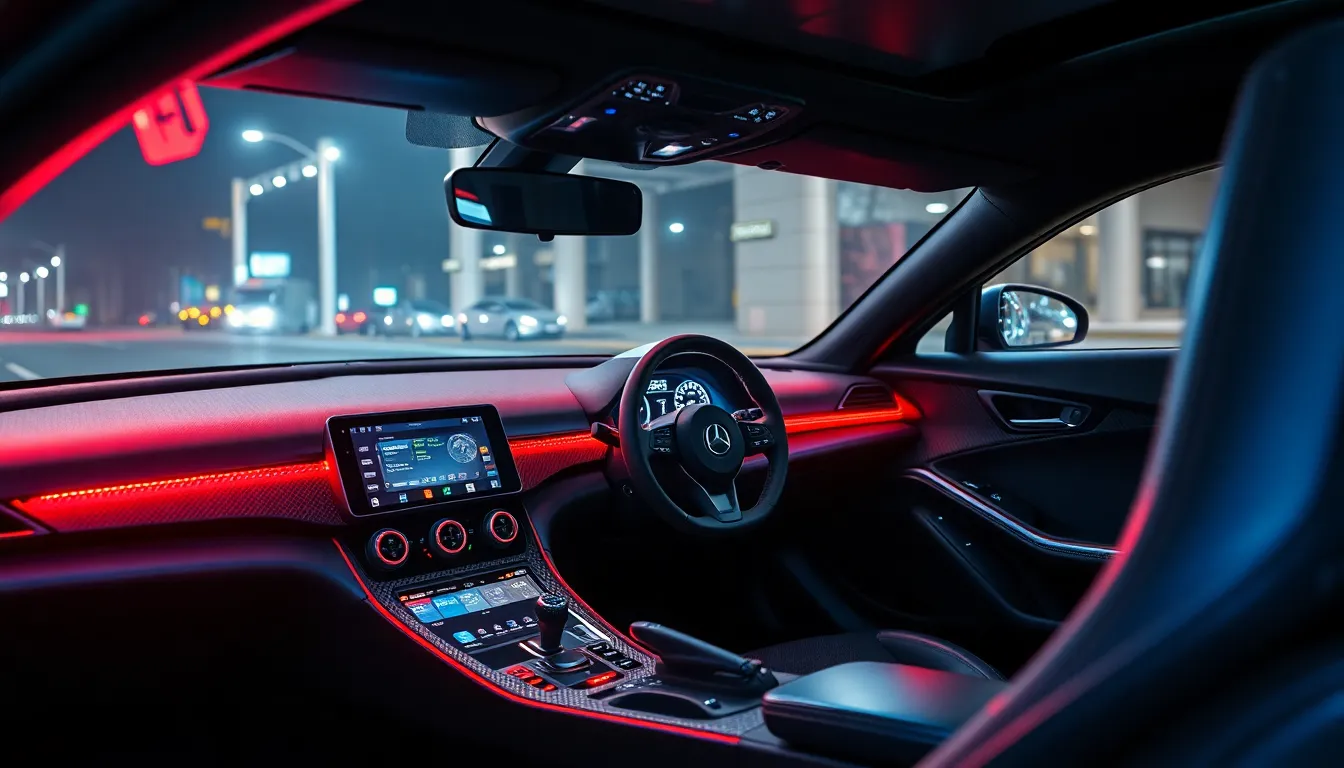
Tokyo’s automotive enthusiasts transform vehicle interiors into sophisticated command centers that rival luxury supercars. These interior upgrades blend cutting-edge technology with Japanese craftsmanship to create immersive driving experiences.
Custom Dashboard and Console Upgrades
Digital instrument clusters replace traditional analog gauges in serious Tokyo builds, offering customizable displays that show real-time performance data. Brands like Defi and HKS produce premium gauge packages that cost between $1,500 and $3,500 for complete setups. Carbon fiber dashboard overlays create seamless surfaces that match exterior styling themes while reducing interior weight.
Touch-screen control panels integrate climate, lighting, and suspension controls into centralized interfaces that eliminate traditional button clusters. Popular brands like Pioneer and Alpine offer systems specifically designed for JDM vehicles, featuring Japanese language support and anime-inspired graphics. Professional installations typically require 15-20 hours of labor and cost between $2,000 and $4,000 depending on complexity.
Center console modifications often incorporate motorized compartments and illuminated storage answers that complement the vehicle’s lighting scheme. Custom fabrication shops in Tokyo’s Akihabara district specialize in creating one-off console designs that integrate charging ports, wireless charging pads, and hidden storage compartments. These bespoke modifications can cost between $3,000 and $6,000 for complete console transformations.
Racing-inspired switch panels replace standard controls with aircraft-grade toggles and push buttons that create authentic motorsport environments. Brands like MoTeC and AiM Sports provide professional-grade control systems that manage engine parameters, data logging, and telemetry functions. Installation costs range from $1,500 to $3,000 for basic setups.
Advanced Audio Visual Systems
High-resolution display screens transform interiors into mobile entertainment centers, with some Tokyo builds featuring multiple screens for passengers and drivers. Premium brands like Kenwood and JVC offer head units specifically calibrated for Japanese market preferences, including karaoke functions and anime-themed interfaces. Complete multimedia systems cost between $4,000 and $8,000 for professional installations.
Custom audio installations often feature 15-20 speakers strategically placed throughout the cabin to create concert-like sound environments. Japanese audio brands like Clarion and Carrozzeria provide systems that integrate seamlessly with vehicle electronics while maintaining factory reliability. High-end installations can exceed $10,000 for complete sound system overhauls.
Ambient lighting systems synchronize with audio playback to create immersive sensory experiences that reflect Tokyo’s neon aesthetic. LED strips and fiber optic cables are woven throughout door panels, dashboard surfaces, and ceiling areas to create customizable color schemes. These lighting upgrades typically cost between $1,500 and $3,500 for complete interior coverage.
Rear seat entertainment systems feature individual screens, gaming consoles, and streaming capabilities that transform vehicles into mobile lounges. Premium installations include motorized screens that retract into custom housings when not in use, maintaining the vehicle’s clean interior aesthetic. Complete rear entertainment packages range from $3,000 to $6,000 depending on screen size and features.
Conclusion
Tokyo’s automotive aesthetic represents more than just car modifications—it’s a living testament to Japan’s ability to transform functional objects into artistic expressions. We’ve witnessed how this vibrant culture continues to evolve while staying true to its foundational principles of precision craftsmanship and innovative design.
The city’s influence on global automotive trends remains undeniable. From the underground racing circuits to social media showcases these vehicles have become cultural ambassadors that showcase Japan’s unique approach to automotive artistry.
What makes Tokyo’s car culture truly special is its embrace of both permanence and change. Whether it’s a meticulously crafted stance build or a seasonal cherry blossom wrap the community celebrates automotive expression in all its forms while maintaining the highest standards of execution and attention to detail.
Frequently Asked Questions
What makes Tokyo’s car culture unique compared to other automotive scenes?
Tokyo’s automotive culture blends advanced technology with traditional Japanese craftsmanship, creating vehicles that are viewed as artistic expressions rather than just transportation. The scene emphasizes engineering excellence, creative flair, and meticulous attention to detail, making it a global influence on car modification trends and aesthetics.
What is the Midnight Club and how did it influence Tokyo’s street racing aesthetic?
The Midnight Club was an underground racing group active since the 1980s that shaped Tokyo’s automotive aesthetic through their preference for sleek, aerodynamic modifications and sophisticated dark paint schemes. Their Wangan racing culture emphasized high-speed engineering and clean lines, prioritizing subtle visual cues that suggest performance capability over flashy modifications.
What are Itasha vehicles in Tokyo’s car culture?
Itasha vehicles are cars featuring anime and manga-inspired character wraps and graphics, originating in Tokyo’s Akihabara district. These vehicles transform cars into rolling galleries celebrating Japanese pop culture, with professional wrap installations typically costing between $3,000 and $8,000 for intricate designs.
How does Tokyo’s stance culture differ from other lowrider traditions?
Tokyo’s stance culture evolved from California lowrider traditions into a distinctly Japanese aesthetic that transforms vehicles into rolling sculptures. It emphasizes precise proportional relationships between wheel size, fender width, and overall vehicle stance, often utilizing air suspension systems and wide body modifications from brands like Rocket Bunny and Liberty Walk.
What role does JDM tuning philosophy play in Tokyo’s automotive scene?
JDM tuning philosophy prioritizes modifications that enhance both performance and visual appeal, focusing on authentic Japanese brands like Mugen and Spoon Sports. This approach emphasizes turbocharger upgrades, engine bay aesthetics, and exhaust systems that combine functionality with striking visual results while maintaining authentic underhood appearances.
How do seasonal modifications work in Tokyo’s car culture?
Tokyo’s automotive enthusiasts embrace seasonal celebrations through temporary vehicle modifications, such as cherry blossom-themed wraps during spring, festival decorations for summer matsuri, and winter illumination displays. These modifications allow car owners to connect their vehicles with Japan’s cultural moments and natural beauty throughout the year.
What are the costs associated with professional car modifications in Tokyo?
Professional modifications in Tokyo vary widely in cost: anime wraps range from $3,000-$8,000, wide body kit installations cost $8,000-$15,000, metallic vinyl wraps range from $2,500-$4,500, and premium gauge packages can reach several thousand dollars. Costs depend on complexity, materials, and the reputation of the installation shop.
How has social media impacted Tokyo’s automotive photography scene?
Social media has transformed Tokyo’s car meets into global showcases, with locations like Daikoku Futo and Oi Pier becoming famous backdrops for viral automotive photography. Professional photographers now charge premium rates for capturing these events, while strategic social media use amplifies Tokyo’s car culture influence worldwide.

